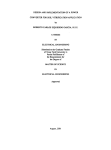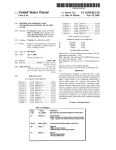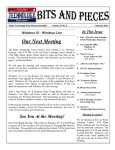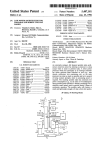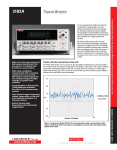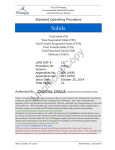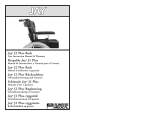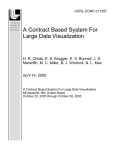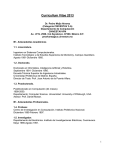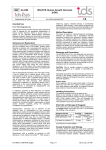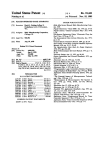Download Motor vehicle washing system with automatic sequencing of different
Transcript
United States Patent [191 Christopher et a1. [11] [45] [54] MOTOR VEHICLE WASHING SYSTEM WITH AUTOMATIC SEQUENCING OF DIFFERENT CLEANING LIQUIDS 3,482,740 12/1969 Evans et a1. . 3,545,459 12/1970 Phillips . 3,567,342 3/1971 Jackson . [75] Inventors: S. Craig Christopher, Little Rock; Donel R. Whiting, Alexander, both of Ark. [73] Assignee: Staley Electric Company, Little Rock, Ark. Patent Number: Date of Patent: 3,575,348 3,664,550 3,667,486 3,674,205 3,687,156 7/1972 8/1972 3,703,187 11/1972 3,760,982 9/ 1973 Kock . Minich, Jr. et a1. . Booth . Haase . 5/1974 Yoeli et a1. ................... .. 134/100 X 8/1974 Heden ........................... .. 134/100 X 3,810,787 3,829,024 [22] Filed: 3,850,371 11/1974 Trapp . [51] Int. Cl.4 .............................................. .. B08B 3/02 3,989,390 11/1976 Thorner . 3,989,391 1l/l976 Throuer . [52] U.S. C1. .................................. .. 134/57 R; 134/95; 4,123,004 10/1978 Jerry . 134/98; 134/100; 134/174; 134/123 [58] Field of Search ................... .. 134/45, 56 R, 58 R, [56] 134/94, 95, 98, 172, 174, 198, 123, 100, 57 R References Cited U.S. PATENT DOCUMENTS 2,506,394 5/1950 Strange . 2,740,415 4/1956 3,007,609 ll/l961 3,021,863 2/1962 Federighi ...................... .. 134/100X Pascucci . Low . 3,049,266 3,049,302 8/1962 Werry . 8/ 1962 Simmons, Jr. .............. .. 134/57 R X 3,081,947 3/1963 Walter ............................ .. 134/57 R 3,103,312 9/1963 Damrow. 3,139,238 6/1964 Norstrud et al. . 3,163,880 1/1965 Johnson. 3,167,091 l/l965 Holdren. 3,229,703 l/1966 Thompson et a1. ............... .. 134/100 3,245,585 4/1966 Dawson. 3,289,942 6/ 1960 Heinicke et a1. . 3,318,535 5/1967 New. 3,322,350 5/1967 Heinicke et al. . 3,361,300 l/1968 Kaplan. 3,369,705 3,369,755 3,383,044 3,392,752 2/ 1968 Curtis et al. . 2/ 1968 Roden et a1. . 5/ 1968 Norstrud et a1. ............. .. 239/414 X 7/1968 Iozziet a1. . 3,443,270 5/1969 Smith. 3,447,505 6/1969 Wagner . 3,454,030 3,454,042 3,459,334 3,481,544 7/1969 Nelson . 7/1969 Phillips ......................... .. 134/100X 8/1969 Evans . 2/1969 Jackson . CHEM WATER SUPPLY ——> 4,290,442 Jul. 18, 1989 4/ 1971 MacKay . 5/ 1972 Carothers et a1. . 6/ 1972 Cole et al. . [21] Appl. No.: 302,963 Jan. 30, 1989 4,848,384 9/ 1981 Shaffer ..................... .. l37/624.18 X 4,306,678 12/ 1981 Schull . 4,335,481 6/ 1982 Slayman . 4,413,785 11/ 1983 Engelbert et a1. . 4,541,568 9/1985 Lich?eld . 4,552,476 11/ 1985 Heraty et a1. . Primary Examiner—Frankie L. Stinson Attorney, Agent, or Firm-Nixon & Vanderhye, P.C. [57] ABSTRACT A liquid application system particularly adapted to being employed in motor vehicle washing is disclosed. The system includes a manually actuable liquid applica tor and a supply subsystem which supplies liquid under pressure to the applicator from several discrete liquid sources. Sequencing control so as to achieve a supply of liquid from one and then another of the sources is achieved by sensing a pressure condition within the liquid supply, such as, an increased pressure which occurs within the liquid supply system when the appli cator is changed from its operable mode to its inopera ble mode. Valving control is then achieved so that fluid communication is cyclically established between the one and another liquid sources in response to a cyclical change of operation of the applicator between its opera ble and inoperable modes. In such a manner, by merely changing the applicator between its operable and inop erable modes, one can effectively select a particular liquid supplied to the applicator. 14 Claims, 4 Drawing Sheets US. Patent Jul. 18,1989 Sheet 1 of 4 4,848,384 ‘l US. Patent Jul. 18, 1989 Sheet 3 of4 4,848,384 410.526 \£1 mmzE. TE? l4 ‘my;Ex mu W0u1m0n.23%m <TL. Y Om\NINmI |_ I. i 1 4,848,384 2 sponse to receipt of each such electrical signal. In such MOTOR VEHICLE WASHING SYSTEM WITH AUTOMATIC SEQUENCING OF DIFFERENT a manner, sequencing of liquid from different sources is CLEANING LIQUIDS FIELD OF THE INVENTION Another system has been proposed in Norstrud US. Pat. No. 3,383,044 et al. According to this prior pro posal, a hydraulically controlled pressure washer in This invention broadly relates to the ?eld of liquid application systems of the type wherein a pressurized pressure conditions existing within a common supply apparently possible. cludes a pressure sensor so as to sense predetermined line ?uid-connected to a pressure wand. The pressure , liquid is supplied to an applicator and is expelled from the applicator onto a desired area of liquid application. 0 sensor activates one of a plurality of switches so as to select the injection of cleaning agents from either, or all, The invention is preferably embodied in a motor vehicle washing system which is capable of being automatically sequenced between several discrete liquids (or liquid mixtures). The invention achieves such sequencing by of such sources. sensing a predetermined pressure condition existing in the liquid line upstream of the applicator and then terms of minimizing user fatigue and facilitating quicker switching automatically from one liquid source to an other in response to such sensed pressure condition. be dispensed through the wand, some improvements are While the above-noted prior proposals may provide some bene?t over strictly manual switching systems in selection between a number of liquid sources desired to still required. For example, it would be desireable (in ' terms of liquid switching responsivenes) if a control BACKGROUND AND SUMMARY OF THE scheme could be provided whereby each successive INVENTION liquid to be dispensed would be in a “stand-by” mode The use of high pressure liquid applicator systems are while the previous liquid in the sequence is being dis generally known and have several uses. One such use is pensed. And, it would also be desireable if this stand-by in the ?eld of motor vehicle wash stations, particularly condition became an active condition (i.e., so as to ex those of the self-serve variety. In these systems, a manu 25 tablish ?uid communication between the next succes ally operated liquid applicator (usually called a sive liquid in the sequence and the wand) during a “no “wand”) is supplied with a stream of high pressure ?ow” condition through the wand. In this way, the lead water (generated by means of a pump) so that the water time necessary for the next successive liquid to be dis is directed towards the motor vehicle by the user. charged from the wand could possibly be minimized. As may be appreciated, the washing of a motor vehi These objects are achieved according to the present cle usually involves several sequences. For example, the invention by means which sense a predetermined pres motor vehicle may ?rst be rinsed with water discharged from the wand so as to provide a preliminary loosening sure condition which occurs within the liquid supply line to the wand. This pressure condition is preferably indicative of a user’s manual opening and closing of the wand. That is, means are provided in accordance with of dirt and grime. This preliminary rinse sequence may then be followed by a wash sequence where a liquid detergent is supplied to the water and this high pressure this invention for sensing the cyclical opening and‘clos liquid mixture of liquid detergent and water may then ing of the wand by a user-which opening and closing be directed towards the motor vehicle. Finally, any respectively decreases and increases pressure conditions detergent residue which remains may then be removed by again directing a high pressure rinse water stream 40 existing in the liquid supply line. In response to at least one of these sensed pressure conditions, valving struc against the motor vehicle. It is also sometimes desirable tures are operated so as to open ?uid communication to apply other chemical additives to the water stream at between at least one liquid source and the wand and to different sequences in the wash cycle. For example, a close ?uid communication between another liquid liquid wax or other surface protective medium may be injected into the water stream and thus applied onto the 45 source and the wand. When the pressure condition is again sensed the ?uid communication between the one motor vehicle via the wand. and other sources and the wand is reversed-that is, In the past, a user’s selection of particular ones of ?uid communication between the wand and the ?rst these various liquid streams usually depended upon a source is closed and ?uid communication between the manually actuated ?uid switch which the user manipu lated each time it was desired to change from one type 50 wand and the other fluid source is opened. As may be appreciated, any number of ?uid sources of liquid stream (i.e. one which may or may not contain have typically been located within the motor vehicle wash bay or as a part of the wand itself (see, Trapp US. containing (or adapted to be supplied with) the same or different liquids may be provided according to this invention and the supply of any particular liquid (or Pat. No. 3,850,371 ). These prior systems thus require 55 combination of liquids) may be selected by a user that the user support the wand with one hand while merely by changing the wand between its operable and inoperable modes (for example, as by merely cyclically squeezing and releasing the trigger of the wand). a chemical additive) to another. These ?uid switches - attempting to manipulate the fluid switch with the other hand-an awkward exercise. And, since the wand itself may be somewhat cumbersome, it is usually insuf? ciently supported by the user during his/her switching Other advantages and aspects of this invention will become clear from the following detailed description of the preferred exemplary embodiment. from one liquid supply to another. This, in turn, may contribute to user fatigue. BRIEF DESCRIPTION OF THE PREFERRED In US. Pat. No. 4,290,442, a cleaning system is pro EMBODIMENT posed whereby each initiation of flow from a source of Reference will hereinafter be made to the accompa water is sensed. An electrical signal is issued in response 65 to each such ?ow initiaion. This electrical signal is then nying drawings wherein like numerals throughout the applied to a switching system which switches between various FIGURES denote like structural elements, and one and another electrically-operated valves in re wherein: 3 4,848,384 4 vehicle washing system in accordance with this inven The pressure sensing valve 49 can be of any suitable type which operates in response to greater/lesser pres tion; sure conditions existing within the line 45 (i.e., in depen FIG. 1 is a schematic elevational view of a motor FIG. 2 is a schematic view of the ?uid supply cir dence upon a user manually operating the wand 22 cuitry employed in the motor vehicle washing system of between its inoperable/operable modes, respectively). One preferred pressure sensing valve 49 is commer FIG. 1; FIG. 3 is a schematic diagram of an exemplary elec cially available from Fluid Control Corporation, Tulsa. Okla, Model No. PR-lOOOA. This preferred valve is a tromagnetic relay-controlled sequencer controller in balanced diaphragm-type valve which moves in re FIG. 4 is a schematic diagram of an exemplary solid O sponse to greater/lesser pressure conditions existing within the line 45. state relay-controlled sequencer controller in accor According to the present invention, valve 49 is modi dance with the present invention. accordance with the present invention; and ?ed so as to include, in the embodiments described DETAILED DESCRIPTION OF THE PREFERRED EXEMPLARY EMBODIMENT FIG. 1 schematically shows, in elevational view, a motor vehicle washing system 10 according to the pres ent invention. System 10 includes a control panel 12 within a vehicle wash bay 13. The control panel 12 has user operable control switch 14 (which controls the starting and stopping of the system 10) and a mode switch 16 (which permits the user to select the particu lar mode for the wash system 10) in addition to indica tor lights 180-180 (which provide the user with a visual indication of the particular mode of operation for the below, a conventional “push-on/push-off’ single-pole double-throw (SPDT) type microswitch 50. The micro switch 50 is preferrably mounted to the diaphragm housing of valve 49 and thus changes state (i.e., switches between its “normally open” and “normally closed” contacts) in response to movements of the dia phragm. That is, the actuator of microswitch 50 is posi tioned with respect to the diaphragm of valve 49 such that the microswitch moves in response to movement of the diaphragm, thereby effecting changes in state of the 25 system 10). As will be discussed in greater detail below, liquid from several sources (for example, “CHEM 1” and “CHEM 2” sources 17 and 19, respectively) is supplied to pump station 20, and then via hose 21 to spray wand 22. The liquid is then discharged from the nozzle tip 24 microswitch 50. Chemical injection of a liquid from source 17 or source 19 is accomplished at junction 54. Solenoid valves 56, 58 are respectively provided in the lines 170, 190 which ?uid communicate the sources 17, 19, respec tively, with junction 54 via line 53. Thus, the liquid from sources 17 and/or 19 ?ows to the junction 54 and may be injected into the water stream within line 45 so for application onto a vehicle 26. The spray wand 22 that it is discharged via the pump 42, through line 46, may be of any conventional type having operable and inoperable modes. Thus wand 22 may generally be comprised of a handle 28 and a trigger 30 which is and then on to spray wand 22. sequencing of liquids as between the water supply only manually depressed by a user so as to allow liquid to (i.e., a “rinse” cycle). The liquid injection from source ?ow through the nozzle 24 when desired, and is re leased when the ?ow of liquid is to be stopped. The liquid sources are schematically shown in FIG. 1 as being water (for example, from a city’s potable water 40 17 and source 19 will be described now with reference to FIG. 3, which shows one embodiment of electronic displacement pump 42 so as to pump water from the circuit thereby operating the motor 40, and hence the water supply, through a solenoid operated shut-off valve 44 in the low pressure inlet line 45, and then to high-pressure discharge line 46. Line 46 is coupled at coupling 48 to hose 21 so that high-pressure liquid may be supplied to spray wand 22. A pressure sensing valve 49 and temperature probe 52 are also provided in the pump 42. Important to the present invention is the selective controller 38 and associated operative components in their de-energized or “off” state. In order to begin 'the washing cycle, a user will manually move the control supply via line 32) and/or from other holding tanks, vessels or the like designated by reference numerals 17 switch 14 to an “on” position. This causes contacts 14a, 14b to close thereby activating the water supply sole and 19 in FIG. 1. Thus, container 17 may provide a noid valve 44 to permit water to be supplied via line 45 source of liquid detergent, for example, which is mixed in station 20 (as will be discussed below) and applied via 45 to the pump 42. It should also be noted that while in the wand 22 to the motor vehicle 26 thereby washing the “on” position, power is supplied across contacts 14a, 14b to contact 140 to the mode switch 16 across contacts same. Tank 19, on the other hand, may contain a liquid 16a, 16b(i.e., since mode switch 16 is shown in the initial wax (or other surface-protective medium) which may be mixed with the water supply and applied via wand 22 “rinse” mode) thereby illuminating the yellow (or to the vehicle 26 at the appropriate cycle in the wash. “rinse mode”) indicator light 18a. The ?uid control system 35 is shown in accompany When it is desired to supply rinse water at this stage ing FIG. 2. Generally, the ?uid control system 35 in in the wash cycle to the wand 22, a user moves the cludes a fluid circuit control subsystem 36 (preferably control switch 14 from the “on” to the “start” position. housed within pump station 20) and an electronic con This causes blade switch 14e to close contacts 14c and troller 38 (preferably housed within panel 12). Switches 14d thereby energizing the motor coil M1 which closes 14, 16 and indicator lights 18a—18c are in electrical com motor contactor MC thereby latching the motor coil munication with controller 38 and, as will be described M1 into an energized state. When the user releases the in greater detail below, a variety of functions in the ?uid control switch 14, it will spring-return from the “start” circuit 36 are controlled/monitored via controller 38. to the “on” position but since the motor contactor MC An electric motor 40 drives a high-pressure, positive 60 is now closed, the motor coil M1 will be latched into the inlet line 45. At this time the user may simply depress the trigger 30 of wand 22 so as to cause liquid to flow through the inlet conduit 45 and to the outlet (high-pressure) side of pump 42 so as to be discharged through nozzle 24 of wand 22. However, if the user does not depress trigger 30 of wand 22 so as to discharge liquid from nozzle 24, 5 4,848,384 the liquid at the inlet side of pump 42 will begin to increase in temperature—i.e., sice pump 42 is of a posi tive displacement variety. Thus, if for a predetermined period of time (e.g., 30 minutes) the pump 42 is in opera tion without water being circulated to the wand ‘22, the temperature probe 52 will sense the resulting tempera 6 mixed with chemicals from sources “CHEM 1” or “CHEM 2”) is being discharged from wand 22. It should be noted here that coils K1 and K2 remain ener‘ gized due to the latch circuitry provided by contacts KIA and K2A, respectively. It should also be noted that when contacts K3A and K3B open with the energi zation of coil K3, the power supply to the common bus ture increase and will open the temperature contact T1 50b of pressure switch 50 is terminated. However, since at some preselected maximum temperature thereby +12 volt DC power is being supplied to the normally shutting off power to the control switch 14 and dis open bus of switch 50 at all times when mode switch 16 abling the motor coil M1 (and hence the motor 40). is in the “AUTO” position, coils K1, K2 and K3 remain With the mode switch 16 in the “RINSE” position, in their energized state (via closed contacts KIA, K2A and with the control switch 14 having been moved to and K2B, respectively). This condition places the con the “START” position, a user may then supply rinse trol circuitry in a “stand-by” mode whereby the next water from the water supply to the vehicle 26 via wand 22. Water flowing through the inlet pipe 45 will cause 5 sequencing of the trigger 30 will allow liquid from “CHEM 1” source 17 to be supplied to line 45 at junc the valve 49 to operate thereby, in turn, changing the tion 54. blade switch 51 of microswitch 50 from its normally Thus, when the user releases trigger 30 (thereby stop open contact NO (as shown in FIG. 3) to its normally ping the ?ow of rinse water being discharged’ from closed contact NC. However, since no power is being nozzle 24 of wand 22), the blade 51 of switch 50 will supplied to the pressure switch 50 at this time (i.e., since change from its normally closed contact NC to its nor the mode switch 16 is in its “RINSE” position), auto matic sequencing control is not affected. mally open contact NO (i.e., in response to operation of When the user desires to automatically cycle between valve 49 due to an increased pressure condition in line the water supply and one or more sources of other 45). This action of blade 51 thereby again supplies liquid, he releases wand trigger 30 (thereby stopping the 25 power to the common bus 50b of switch 50 and thus ?ow of liquid from the wand) and manually moves the mode switch 16 from its “RINSE” position to its “AUTO” position. Moving the mode switch 16 to the “AUTO” position opens contacts 16a, 16b and simulta neously closes contacts 16c, 16d so as to supply power to the normally open bus 50a of the pressure switch 50. An increased pressure condition within line 45 will thereby be sensed by means of valve 49, causing the energizes coil K4 through contact K3C (closed upon the prior energization of coil K3) and normally closed contact K6A. Coil K4 is held in its energized state due to the closing of normally open contact K4A. It will be noted here that contact K4B also closes when coil K4 is energized thereby energizing solenoid S1 of valve 56 to thus permit liquid from “CHEM 1” source 17 to flow to the junction 54 of the liquid circuit 36. At this time, contact K4C opens thereby extinguish valve to operate so as to change the state of micro switch 50 from its NC contact to its NO contact. 35 ing indicator light 18a (which had remained illuminated When the blade 51 for the pressure switch 50 has to this point in the control scheme via power supplied to moved from its normally closed contact NC to its nor contact 16b of switch 16 through contacts K4C and mally open contact NO, +12 Volt DC power will then be supplied via blade 51 through the normally open NO KlB, the latter closing upon energization of coil K1——i.e., simultaneously with switch 16 being moved to and common contact C of the pressure switch and the “AUTO” position). However, since contact K4B is through normally closed relay contact K3A so as to closed, the indicator light 18b is illuminated thereby energize relay coil K1. Energization of coil K1 thereby, giving the user visual indication that he/she is in the in turn, closes normally open relay contact K1A thus holding coil K1 in its energized state. Thus, power is “CHEM 1” mode. Thus, when the user depresses trig ger 30 of wand 22, liquid from the source 17 will be now supplied to the common bus 50b of pressure switch 45 injected into the water at junction 54 and will be trans 50 via closed contacts K1A and K3A (and power is ferred to the spray wand 22 under pressure via pump 42. supplied to “rinse” light 180 via normally closed It should also be noted that, at this time, the blade 51 contact K4C and normally open but now closed contact for the pressure switch 50 changes, in response to the KIB). Contact K1C opens to prevent solenoid 58 from decreased pressure condition then existing in line 45 being energized. sensed by means of the valve 49, from its normally open In this mode (i.e., the mode switch 16 in the “AUTO” contact NO to its normally closed contact NC. That is, position and the coil K1 energized as indicated above), when a user squeezes the trigger 30 of wand 22, rinse water will be exhausted from nozzle 22. In addition, the blade 51 of pressure switch 50 will move from normally open contact NO to its normally closed contact NC. When the user squeezes the trigger, user applied to the common bus 50b of the pressure switch 50 is then supplied to the normally closed bus 50c thereof via the blade 51. This, in turn, supplies power to coil K2 via normally closed contact K3B, thereby energizing coil K2. Energization of coil K2 closes contact K2A thereby holding coil K2 in its energized state. Also, a decreased pressure condition now exists in line 45, causing blade 51 to move in response. Power is there fore supplied to the normally closed bus 500 of switch 50 through contacts K6A and K3C so as to energize coil K5. Coil K5 is maintained in its energized state by the closure of contact K5A. Contact KSB also closes in response to energization of coil K5 and, since 3O 12 volt DC power is being constantly supplied to the normally open bus 50a of switch 50, coil K6 is energized. Energi zation of coil K6, in turn, opens contact K6A and K6B but, since contacts K4A and K5A remain closed, coils K4 and K5 remain in their energized state. It should be contact K2B closes when coil K2 energizes and, since noted that although contacts K3E and K6C are now constant +12 volt DC power is being supplied to the 65 closed (since coils K3 and K6 are respectively ener normally open bus 50a of pressure switch 50, coil K3 is gized) coil K7 is not energized since no power is being energized which opens normally-closed contacts KSA supplied to the common bus 50b of switch 50 at this and K3B. In this mode, rinse water (i.e., water not time. That is, contact K6A is opened (but coil K4 re 7 4,848,384 mains energized through contact K4A) and thus com 8 As can be seen therefore, the present invention per mits cyclic sequencing between rinse only, and between mon bus 50b is not supplied with power. Thus, at this time, all coils K1 through K6 are in an energized state. the liquid in sources 17 and 19 so that the user can When the user again releases trigger 30 of wand 22, the blade 51 of pressure switch 50 will then change from its normally closed contact NC to its normally open mixture) to be applied to the vehicle 26 merely by man ual operation of the trigger 30 of wand 22. contact NO (i.e., since an increased pressure condition now exists in supply line 45 due to the closure of wand 22). Power is therefore supplied through now closed contacts K3E and K6C so as to energize coil K7. Contact K7A is thus closed so as to hold coil K7 in an selectively determine the particular liquid (or liquid FIG. 4 is a schematic diagram of a further presently preferred exemplary embodiment of electronic control ler 38 in accordance with the present invention, this further embodiment using all solid state components for improved reliability and compactness. The heart of the energized state. With the energization of coil K7, coils K1 through K6, inclusive, are de-energized due to the FIG. 5 controller 38 is a CMOS decade counter/ divider opening of contact K7B. This, in turn, causes contacts KIB and KlC to revert to their normally opened and controls the current state of the system and sequences between states in response to sensed pressure increases normally closed conditions, respectively. Contact K4C via valve 49 and microswitch 50. 100 (type 4017 in the preferred embodiment) which also reverts to its normally closed condition as shown so The Q0, Q1 and Q2 outputs of counter/divider 100 that the solenoid coil S1 of valve 56 is de-energized and are used to control the on/off states of solid-state relays the indicator light 18b is extinguished. Simultaneously, 102, 104, 106 respectively. Signals appearing on any other of the outputs of counter/divider 100 (i.e., outputs Q3-Q9 and the carry output CO) force the device to however, solenoid coil S2 of valve 58 is energized and the indicator light 18c is illuminated (since contacts K4C and KlC are in their normally closed positions) thereby permitting liquid from “CHEM 2” source 19 to ?ow to junction 54 while terminating fluid communica reset to its initial Q0 state via diode bank 108 and the reset input (RST). A conventional power-0n reset-type circuit 110 including a resistor R3 and a capacitor C3 tion between the line 45 and “CHEM 1” source 17. The 25 connected to the input of a Schmitt trigger 112 applies a power-on reset pulse to the RST input of counter/di illumination of indicator light 18C thus gives the user vider 100 when power is ?rst applied to controller 38 so visual indication that he/she is now in the “CHEM 2” as to reset the counter/divider into its initial Q0 output mode. state. Another Schmitt trigger circuit 114 provides a Thus, when the trigger 30 of wand 22 is again de pulse of a duration controlled by the values of resistor pressed so as to allow liquid to be discharged from R4 and capacitor C4 whenever microswitch blade 51 nozzle 24, the valve 49 will again sense a decrease in ?rst contacts its normally open contact 500 in response pressure and thus blade 51 of microswitch 50 will move from its normally closed contact NC to its normally open contact NO. Since no power is now being supplied at this time to the coil K7 via the normally open bus 50a to release of the wand trigger 30. Although counter/di vider 100 is a synchronous device, its clocking input is tied to V“ and the counter/divider changes state asyn (i.e., since contact K7B has previously opened), coil K7 is de-energized. However, power is still being supplied chronously in response to pulses received on its ENA in line 45 so that a mixture of the liquid in source 19 and output; by disabling its Q2 output and enabling its Q3 input from Schmitt trigger 114. In the preferred em to the solenoid S2 of valve 58 due to the normally bodiment, control/divider 100 is actually operated in a shift register mode in which each one of its outputs Q0, closed contact K4C and KlC and the fact that power is constantly supplied to the normally open bus 50a of 40 Q1 and Q2 is active at a time. Each time counter/di vider 100 receives an ENA pulse, it changes its state switch 50 when in the “AUTO” mode. Thus, even though coil K7 is de-energized, liquid from source 19 is (e.g., by disabling its Q0 output and enabling its Q1 still permitted to flow to junction 54 and mix with water output; by disabling its Q1 output and enabling its Q2 45 output; etc.) as those skilled in the art are well aware water is supplied to the spray wand 22. from commonly-available data sheets describing the When the user again releases trigger 30 to thereby terminate the spray of liquid from nozzle 24, the valve type 4017 CMOS decade counter/ divider. The operation of the electronic controller 38 shown 49 will again sense an increased pressure condition ex in FIG. 5 will now be described. isting within line 45 and will, in turn, cause blade 51 of microswitch 50 to be responsively moved from its nor When DC voltage is ?rst applied to connector CON mally closed contact NC to its normally open contact 1 (either from a 12 vdc source or from a conventional NO. This movement therefore begins the cycle anew. line voltage step-down transformer and associated That is, coil K1 is now energized via power supplied to bridge recti?er or the like), capacitor C5 provides ?l the normally open contact through the common bus 51b tered 12 VDC voltage through 5 amp fuse F2 to various and through normally closed contact K3A. Coil K1, as points in controller 38, including: has been described, is then latched into the circuit via (a) CLK and power inputs of counter/ divider 100; contact KIA which closes upon energization of coil K1. (b) the common (0) terminal 50B of microswitch 50; Hence, if the user again depresses the trigger 30 of wand (c) the “line” side of control switch 14 via connector 22, “rinse” water only from line 32 will be supplied CON 2, terminal 2, (and also to the pump station 36 through line 21—-i.e., ?uid communication between as described previously via temperature sensor sources 17 and 19 will have been terminated as de contacts T1 also as described previously); scribed above. (d) the input of Schmitt trigger 112. Of course, at any time during the wash sequence, if In response to this initial application of power, Schmitt mode switch 26 is moved from the “AUTO” position to trigger 112 ?res and pulses the RST input of counter/di the “RINSE” position, power to the microswitch 50 is 65 vider 100 through diode D5. This outputted pulse terminated. Thus, only during the “AUTO” mode is causes counter/ divider 100 to reset so that output Q0 is power supplied to microswitch 50 thereby permitting automatic selective sequencing of liquids. high and all other outputs are low. Input voltage to Schmitt trigger 112 decays as capacitor C3 charges so 4,848,384 that the output of the Schmitt trigger remains high only 10 that the invention is not to be limited to the disclosed embodiment, but on the contrary, is intended to cover for a short period of time suf?cient to ensure the coun ter/divider 100 is reset. various modi?cations and equivalent arrangements in cluded within the spirit and scope of the appended With mode switch 16 in the “auto” position (as previ ously described), when the control switch 14 is turned to the “start” position (see FIG. 3) the pump motor M1 claims. What is claimed is: 1. A motor vehicle washing system comprising: a primary source of liquid and a secondary source of is energized (thereby pressuring the system). The result ing pressure at valve 49 causes the microswitch blade 51 liquid intended to be mixed with liquid from said primary source; a manually actuable ?uid applicator having: an opera to contact normally open contact 50a-—thereby apply ing 12 VDC to contact 50a and thus to the input of Schmitt trigger 114 via R4 and C4. Schmitt trigger 114 applies a pulse to the ENA (“enable”) input of coun ter/divider 100, causing the counter/divider to disable its Q0 output and to enable its Q1 output. The now tive condition wherein liquid is allowed to be dis charged therefrom, and an inoperative condition, wherein liquid is prevented from being discharged active Q1 output energizes the “rinse” solid state relay 5 therefrom; ‘ supply means which ?uid-connect said primary and 104, and causes the “rinse” indicator 18a to be illumi nated through mode switch 16, connector CON 2, ter secondary liquid sources one to another and to the minal 1; jumper J2; the internal triac of rinse relay 104; liquid applicator for supplying said liquids there and connector CON 4, terminal 1. The duration of the pulse provided by Schmitt trigger 114 is relatively short 20 since the input voltage to the Schmitt trigger decays as capacitor C4 charges. Depressing wand trigger 30 allows rinse water to flow from nozzle 24. The resulting vacuum created at from to the liquid applicator; and sequencing control means in operative association with said supply means for (i) sensing a predeter mined liquid pressure condition within said supply means, and (ii) switching automatically between a primary liquid supplied to said supply means solely valve 49 causes microswitch blade 51 to return to nor 25 from said primary liquid source and a mixture of mally closed contact 50c, disconnecting power from the input of Schmitt trigger 114 and allowing capacitor C4 sources to be supplied to said supply means in re to discharge (if desired, in part through grounded nor mally closed contact 500). When the user again releases wand trigger 30, micro sequencing between said primary liquid and said liquid mixture is selectively controlled, and switch blade 51 returns to normally open contact 50a-causing Schmitt trigger 114 to provide another pulse to the counter/divider 100 ENA input. In re sponse to this pulse, counter/divider 100 disables its active Q1 output and enables its Q2 output. The Q2 output is connected to energized the “CHEM 1” solid state relay 106, in turn energizing the “CHEM 1” sole noid 56 (via connector CON 4, terminal 2). Indicator 18b also illuminates as describes previously. Depressing wand trigger 30 allows water and chemical 1 to flow from nozzle 24, and also controls microswitch blade 51 to return to the normally closed 500 (thereby facilitating discharge of capacitor C4). When wand trigger 30 is again released, microswitch blade 51 again returns to the normally open contact 50a to provide yet another pulse from the output of Schmitt trigger 114. In response to this further pulse, counter/ divider 100 disables its Q2 output and enables its Q3 output. Since counter/divider output Q3 is tied back to the RST input of the counter/divider via diode D13, the counter/divider resets to disable its Q3 output and liquids from both said primary and said secondary sponse to said sensed pressure condition, whereby wherein said sequencing control means includes: (a) solenoid valve means associated with said sec ondary liquid source, said valve means having a ?rst state wherein no ?uid communication exists between said secondary source and said supply means, said valve means having a second state wherein fluid communication is present between said secondary source and said supply means so as to allow liquid from said secondary source to mix with said primary liquid from said primary source thereby forming said liquid mixture; (b) pressure sensing means in operative association with said supply means for sensing ?rst and sec ond pressure conditions within said supply means; (c) switch means operatively connected to said pressure sensing means and being movable be tween ?rst and second positions in response to said sensed ?rst and second pressure conditions within said supply means; (d) ?rst, second and third relay means each having enable its Q0 output. Output Q0 energizes solid state energized and deenergized states operatively relay 102 to in turn energize the “CHEM 2” solenoid 58 and associated indicator lamp 180. When the user next depresses wand trigger 30, microswitch blade 51 moves to the normally closed contact 500 to facilitate dis charge of capacitor C4 in preparation for the next re lease of the wand trigger. When wand trigger 30 is next released, microswitch blade 51 once again connects to normally open contact 50a so that a pulse is provided from Schmitt trigger 112 to disable the Q0 output of counter/divider 100 and to enable output Q1. The ac connected to said switch means; (e) latching circuit means which operatively inter connects said ?rst, second and third relay means to said switch means, for sequentially (l) causing said ?rst relay means to assume said energized state thereof while maintaining said second and third relay means in said deenergized states thereof when said switch means is initially in said ?rst position, (2) maintaining said ?rst relay in said energized state thereof during and after tive output Q1 energizes rinse solid state 104 to provide a “rinse” visual indication (thus beginning the cycle all movement of said switch means from said initial over again). 65 While the invention has been described in connection with what is presently considered to be the most practi cal and preferred embodiment, it is to be understood said second relay means to assume its said ener ?rst position to said second position, (3) causing gized state while maintaining at least said third relay means in said deenergized state thereof when said switch means is in said second position 4,848,384 12 . 11 said ?rst position, (2) maintaining said ?rst relay in said energized state thereof during and thereof, (4) causing said solenoid valve means to assume its said second state in response to energi zation of said second relay means, whereby said after movement of said switch means from said liquid mixture is formed, (5) maintaining said intial ?rst position to said second position, (3) second relay means in said energized state when said switch means reverts from said second posi causing said second relay means to assume its said energized state while maintaining at least said third relay means in said deenergized state tion to said ?rst position thereof, (6) energizing said third relay means in response to said switch thereof when said switch means is in said sec means reverting to said ?rst position, and (7) causing said ?rst and second relay means to each ond position thereof, (4) causing said valve assume said deenergized states thereof in re said wand and said second liquid source and thus close communication between said wand and said ?rst liquid source in response to ener means to open fluid communication between sponse to said third relay means being in said energized state. 2. A motor vehicle washing system as in claim 1, wherein said supply means includes a pump for supply 5 ing liquid under pressure to said liquid applicator. 3. A motor vehicle washing system as in claim 1, gization of said second relay means, (5) main taining said second relay means in said ener gized state when said switch means reverts from said second position to said ?rst position thereof, (6) energizing said third relay means further comprising manually selectable mode switch means for selectively disabling said control means so in response to said switch means reverting to that only liquid from said primary liquid source is per mitted to be supplied to said liquid applicator, and for said ?rst position, and (7) causing said ?rst and second relay means to each assume said deen selectively enabling said control means when sequenc ergized states thereof in response to said third relay means being in said energized state. ing of liquid from said primary and secondary liquid sources is desired. 5. A system as in claim 4, wherein said spray wand 4. A system which applies liquid onto an object com 25 includes a manually actuated trigger to permit said prising: liquid to be expressed therefrom when said trigger is a manually actuable spray wand; ?rst and second sources of liquid; conduit means for fluid connecting said spray wand with said ?rst and second liquid sources; and means for allowing selective sequencing of liquid depressed and to prevent liquid from being expressed therefrom when said trigger is released. 6. A system as in claim 5, wherein said predetermined pressure condition is created in said conduit means when said trigger is released. application from said ?rst and second liquid 7. A system as in claim 4, further comprising pump means for delivering liquid from said one and other liquid sources to said wand under pressure. 8. A system as in claim 4, wherein said conduit means sources, said sequencing means including, (i) pressure sensing means for sensing a predeter mined pressure condition within said conduit means; (ii) valve means for respectively opening and clos ing ?uid communication between said wand and includes ?rst and second liquid supply paths for respec tively fluid connecting said ?rst and second liquid ?ows through said wand and is applied to the object when said wand is manually actuated; and (iii) control means operatively interconnecting said said ?rst and second valves being responsive to said sources to said wand, and wherein said valve means said ?rst and second liquid sources so that liquid from one of said ?rst and second liquid sources 40 includes ?rst and second valves disposed in said ?rst and second liquid supply paths, respectively, each of sensed pressure condition so as to sequentially cycli pressure sensing means and said valve means and cally open and close fluid communication between said being responsive to said sensed predetermined 45 wand and said one and other liquid sources in response pressure condition for activating said valve means to thereby selectively control liquid appli cation onto said object from said ?rst and second sources, said control means including; (a) switch means operatively connected to said pressure sensing means and being movable between ?rst and second positions in response to said sensed pressure condition within said supply means; (b) ?rst, second and third relay means each hav 55 ing energized and deenergized states opera tively connected to said switch means; and (c) latching circuit means which operatively interconnects said ?rst, second and third relay means to said switch means, for sequentially (l) causing said ?rst relay means to assume said energized state thereof so as to cause said valve means to open communicatin between said ?rst liquid source and close communica tion between said wand and said second liquid 65 source, while maintaining said second and third relay means in said deenergized states thereof when said switch means is initially in to cyclical depression and release of said wand trigger. 9. A vehicular washing system comprising: a wand including a nozzle and a manually actuable valve in ?uid coupling with said nozzle, said valve alternately inhibiting and permitting the ?ow of fluid from said nozzle; a pressurized ?uid source coupled to said wand; pressure sensing means coupled to said fluid source for detecting an increase in pressure responsive to said valve inhibiting said ?uid ?ow and for produc ing a ?rst pulsed signal in response to said detected pressure increase; state register means connected to receive said ?rst pulsed signal for sequencing between ?rst and sec ond mutually exclusive states in response to receipt of said ?rst pulsed signal, said state register means producing an output signal Q2 when in said second state and inhibiting producing said output signal Q2 when in said ?rst state; solid state relay means connected to receive said Q2 output signal for producing a solenoid driving sig nal in response to receipt of said Q2 signal; a source of ?uid additive; and 13 4,848,384 14 solenoid means, connected between said ?uid addi tive source and said wand and connected to receive means for converting said electrical signal to a pulsed said solenoid driving signal, for permitting said 12. A vehicular Washing system as in claim 11 signal. wherein said converting means comprises: ?uid additive to mix with said pressurized ?uid in response to said solenoid driving signal. 10. A vehicular washing system as in claim 9 wherein said state register means comprises a counter/divider RC network means for conditioning said electrical signal; and Schmitt trigger means connected to receive said con ditioned signal for producing said ?rst pulsed sig having an enable signal, said counter/divider operating in a shift mode in response to receipt of said pulsed signal. nal. 10 11. A vehicular washing system as in claim 9 wherein said pressure sensing means comprises: ' 13. A vehicular washing system as in claim 9 wherein said state register means includes means for automati cally resetting to said ?rst state when said pulsed signal is received and said state register means is sequenced into said second state. 14. A vehicular washing system as in claim 13 wherein said register means comprises a synchronous a further valve in ?uid communication with said pressurized ?uid source, said valve including a diaphragm which moves in response to an increase in pressure of said pressurized ?uid; and microswitch means mechanically connected to said sequential state circuit having a synchronizing clock input CLK and an asynchronous input, said pulsed diaphragm, said microswitch means for producing an electrical signal each time said diaphragm clock input being connected to a constant signal level. signal being applied to said asynchronous input, said * moves in response to said pressure increase; and 25 35 45 50 55 60 65 * 1k * *













